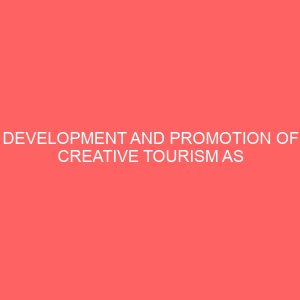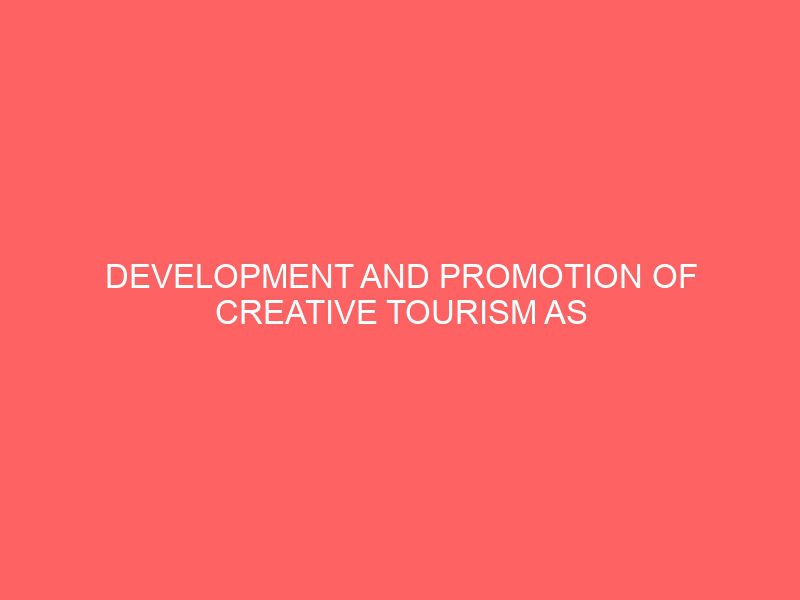CHAPTER ONE
INTRODUCTION
This project is on development and promotion of creative tourism as a panacea for economic sustainability in Ekiti state. Creative Tourism (or culture tourism) is the subset of tourism concerned with a country or region’s culture, specifically the lifestyle of the people in those geographical areas, the history of those people, their art, architecture, religion(s), and other elements that helped shape their way of life. Creative tourism includes tourism in urban areas, particularly historic or large cities and their creative facilities such as museums and theatres. It can also include tourism in rural areas showcasing the traditions of indigenous creative communities (i.e. festivals, rituals), and their values and lifestyle, as well as niches like industrial tourism and creative tourism. It is generally agreed that creative tourists spend substantially more than standard tourists do. This form of tourism is also becoming generally more popular throughout the world, and a recent OECD report has highlighted the role that creative tourism can play in regional development in different world regions.
Creative tourism has been defined as ‘the movement of persons to creative attractions away from their normal place of residence, with the intention to gather new information and experiences to satisfy their creative needs’. These creative needs can include the solidification of one’s own creative identity, by observing the exotic “other“.
Creative tourism has a long history, and with its roots in the Grand Tour is arguably the original form of tourism. It is also one of the forms of tourism that most policy makers seem to be betting on for the future. The World Tourism Organisation, for example, asserted that creative tourism accounted for 37% of global tourism, and forecast that it would grow at a rate of 15% per year. Such figures are often quoted in studies of the creative tourism market (e.g. Bywater, 1993), but are rarely backed up with empirical research.
A recent study of the creative consumption habits of Europeans (European Commission 2002) indicated that people visited museums and galleries abroad almost as frequently as they did at home. This underlines the growing importance of creative tourism as a source of creative consumption. The generalisation of creative consumption on holiday, however, points to one of the main problems of defining creative tourism. What is the difference between creative visits on holiday (creative tourism) and creative visits undertaken during leisure time at home? Much of the research undertaken by the Association for Leisure and Tourism Education (ATLAS) on the international creative tourism market (Richards 1996; 2001) has in fact underlined the high degree of continuity between consumption of culture at home and on holiday.
In spite of these problems, policy makers, tourist boards and creative attraction managers around the world continue to view creative tourism as an important potential source of tourism growth. There is a general perception that creative tourism is ’good’ tourism that attracts high spending visitors and does little damage to the environment or local culture while contributing a great deal to the economy and support of culture. Other commentators, however, have suggested that creative tourism may do more harm than good, allowing the creative tourist to penetrate sensitive creative environments as the advance guard of the mass tourist.
One type of cultural tourism destination is living cultural areas. Visiting any culture other than one’s own such as traveling to a foreign country. Other destinations include historical sites, modern urban districts, “ethnic pockets” of town, fairs/festivals, theme parks, and natural ecosystems. It has been shown that cultural attractions and events are particularly strong magnets for tourism. The term cultural tourism is used for journeys that include visits to cultural resources, regardless of whether it is tangible or intangible cultural resources, and regardless of the primary motivation. In order to understand properly the concept of cultural tourism, it is necessary to know the definitions of a number terms such as, for example, culture, tourism, cultural economy, cultural and tourism potentials, cultural and tourist offer, and others.
Through valorization of tradition and indigenous values, small historic towns need to attract modern tourist interests and reposition themselves on the turbulent tourism market as distinctive oases of cultural and creative tourism. The affirmation of selective forms of tourism, especially those based on cultural and historical heritage, creativity and innovation, can enable a sustainable creation of attractive contents for both tourists and the local population (quality of life, encouraging entrepreneurial activity, retaining young population, etc.)
The relevance of this research arises from the hypothesis that small historic towns can position themselves on an increasingly demanding tourism market solely on the basis of an indigenous offer and creative tourism in terms of sustainable development.
In developing a creative destination brand, the research relies on the situation analysis. The analysis of the current situation provides a critical overview of small historic towns and their position on the tourism market, pointing to the unfortunate lack of awareness about the possibilities of creative tourism development and the lack of research on the topic. The paper defines the goals of development and the specific concrete ways of innovating strategies in the affirmation of creative tourism in creating the destination brand. Local residents and businesses need to evolve into key creators of a new tourism offer and a new, personalized view of tourists as active co-creators and promoters of an indigenous offer and a unique experience.
Ekiti is a state in western Nigeria, declared a state on 1 October 1996 alongside five others by the military under the dictatorship of General Sani Abacha. The state, carved out of the territory of old Ondo State, covers the former twelve local government areas that made up the Ekiti Zone of old Ondo State. On creation, it had sixteen Local Government Areas (LGAs), having had an additional four carved out of the old ones. Ekiti State is one of the thirty-six states (Federal Capital Territory (Nigeria)) that constitute Nigeria. Ekiti State is reputed to have produced the highest number of professors in Nigeria. Several pioneer academics are from the state, including Adegoke Olubummo (One of the first Nigerian professors in the field of mathematics), Ekundayo Adeyinka Adeyemi (1st Professor of Architecture in Africa, South of Sahara). Others include Profs J.F. Ade-Ajayi, Niyi Osundare,Sam Aluko, Prof A.A. Agboola.
Following a prolonged political crisis, President Olusegun Obasanjo imposed a military administrator (General Tunji Olurin) on Ekiti State in October 2006. On April 27, 2007 Olurin was replaced by Tope Ademiluyi. In the PDP primary of 2006, 1st-place finisher, Yinka Akerele and 2nd place Prof. Adesegun Ojo were supposed to be in a run-off to determine who would be the nominee of the Nigerian ruling party when President Obasanjo summoned them to Abuja and imposed the candidate who came third – Engineer Segun Oni. He was later elected in the 2007 election as the governor of the state in an election marred by widespread irregularities and the AC candidate, Dr. Kayode Fayemi challenged his election and forced a rerun in May 2009.
The May 2009 rerun was characterized by even worse rigging and the election was disputed again. Eventually, after three years, the election of Oni was thrown out and Dr. Kayode Fayemi was declared the duly elected governor of Ekiti State.
Ekiti was an independent state prior to the British conquest. It was one of the many Yoruba states in what is today Nigeria. Ekiti as a nation and districts of Yoruba race had her progeny in Oduduwa, the father and progenitor of Yoruba race. Just like every major sub ethnic division in [Yoruba land]. Ekiti has her origin from Ile-Ife (the cradle land of Yoruba land). The Olofin, one of the sons of the Oduduwa had sixteen (16) children and in the means of searching for the new land to develop, they all journeyed out of Ile-Ife as they walked through the Iwo – Eleru(crave) near Akure and had stop over at a place called Igbo-Aka(forest of termites) closer to Ile-Oluji.
The Olofin, the sixteen children and some other beloved people continued with their journey, but when they got to a particular lovely and flat land, the Owa-Obokun(the monachy of Ijesha land) and Orangun of Ila decided to stay in the present Ijesha and Igomina land of in Osun state. While the remaining fourteen (14) children continued with the journey and later settled in the present day Ekiti land. They discovered that there were many hills in the place and they said in their mother’s language that this is ‘Ile olokiti’ the land of hills. Therefore, the Okiti later blended to Ekiti. So Ekiti derived her name through hills.
Creative tourism formally known as cultural tourism has been seen as another way of creating employment to reduce the steaming number of unemployment in our country today. It is sad to discover today however that the section of the tourism industry which is so promising has reminded unharnessed by the society who haven’t seen or perceived its richness. This research work therefore will attempt to explore its employment opportunity as have been done in Ekiti state in attempt to get the other states in Nigeria to join suit.
The following forms the objectives of the study;
- To explore the employment opportunity in creative tourism using Ekiti state as a case study
- To educate the unemployed youths have creative gift of nature to venture into creative tourism
- To highlight the challenges facing tourism and creative tourism in Nigeria
- To draw the attention of the government towards the challenges facing the tourism industry in attempt to see these challenges challenged.
In attempt to fully comprehend the topic of discussion, the researcher devised some research questions which he believes will generate a better understanding of the topic through an attempt to answer them. The questions include;
- Are there employment opportunities in the creative tourism sector?
- What are the main challenges facing the creative tourism industry?
- In your state, what is the level of creative tourism?
- Is the government of your state supporting the growth of tourism and creative tourism?
- Do you have gift of creativity?
- What is creative tourism?
The following forms the research hypothesis of the study;
HI: Creative tourism is another section of tourism that can create employment opportunities
HO: Creative tourism is another section of the tourism industry that cannot create employment opportunity.
HI: Encouragement of creative tourism can reduce the rate of unemployment among the youths
HO: Encouragement of creative tourism cannot reduce the rate of unemployment among the youths
HI: Encouragement of creative tourism in the state will reduce crime since more jobs will be created
HO: Encouragement of creative tourism in the state will not reduce crime since no employment opportunities will be created.
- SIGNIFICANCE OF THE STUDY:
It is the belief of the researcher that the government, the students, the unemployed and the tourism industry stands to benefit from this research work.
The government stands to benefit from the work since it will educate them on the need to support the creative tourism industry to grow since more employment opportunities will be created through it thereby reducing crime in the society.
The students will also benefit from the research as they will learn more about the creative tourism and the opportunities imbedded in it. The unemployed according to the research stands to benefit more from this study since most of them have creative gifts. It is the belief of the researcher that if these youths that are unemployed will venture into creative tourism, they won’t have any need again to look for white collar jobs.
The project work is sectioned into five different chapters. The chapter one covers the basic introduction concerning the topic, chapter two covers the literature review, chapter three covers the research methodology employed by the researcher, chapter four covers the presentations of the findings of chapter three and chapter five covers the summary, conclusion and recommendation of the study
During the course of researching the project work, the researcher came across a lot of challenges which in one way or the other delayed the work. The following are the challenges encountered by the researcher;
- Financial constraints
- Limited time for the research work
- Problem sourcing for materials
- Problem of convincing people to fill in the distributed questionnaires.








Reviews
There are no reviews yet.